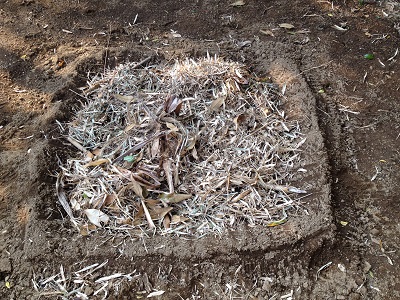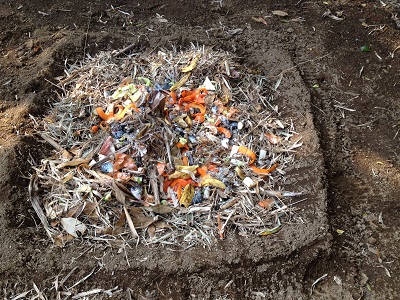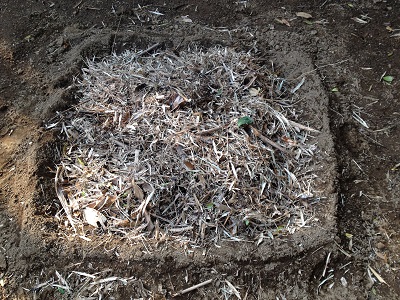 Subtropical
Composting Subtropical
Composting
I decided to put my thoughts about composting on the site without necessarily
going into a lot of detail. The truth is there is plenty of information online
and everyone has a "recipe" for the best compost pile.
I am experimenting with my own recipe now and will continue to write about which
methods work.
Picture - Kitchen scraps
used for green materials in the compost pile including fish.
Composting on this small island in Japan is challenging thanks to the
subtropical climate, which includes a Summer rainy season that rivals the
monsoons of India. The torrential rains and the overall generally wet climate
makes drying out the compost problematic. Composting is definitely worth the
effort though and there are workarounds. |
|
|
Common Knowledge
Regardless of the method you choose, there is still a basic set of rules for
composting. The consensus is you need the following four ingredients for a
successful compost pile. Use proper ratios of these materials. |
- Carbon
- For energy. The microbial
oxidation of carbon produces heat. High carbon materials
are brown
and dry.
- Nitrogen
- To grow and reproduce more
organisms to oxidize the carbon. High nitrogen materials
are green (or colorful, such as fruits and
vegetables) and wet.
- Oxygen
- For oxidizing the carbon, the
decomposition process.
- Water
- To
maintain activity without causing anaerobic conditions.
|
|
Also consider the following: |
- Beneficial
bacteria works to heat
up the pile. A hotter pile (135°-160° Fahrenheit / 50° - 70°
Celsius) needs air and water more often although too much air, water,
and carbon, or too little nitrogen slows down the
process.
- A carbon and
nitrogen mix of about 30 to 1 is best.
Mixing equal amounts of each by volume approximates the ideal C/N
range.
- Nearly all plant and animal materials have both carbon and
nitrogen, but amounts vary widely.
- Human urine can be put onto compost.
- Vermicompost is the product or process of composting through
the utilization of various species of worms.
- A compost pile needs to be turned or mixed periodically
in order to keep the pile aerated.
|
 Composting Piles Composting Piles
I am using succession
piles which required a fallow strip to accommodate a few
adjacent piles. This method makes the turning process much easier since a ready
to be turned pile can simply be moved to an adjacent spot.
Each pile is about 3 meters
by 3 meters square. I am planning to make a total of four
piles.
In addition, I made a pile of brown material in order to keep a ready supply on
hand for each time green material is added.
Picture - The first pile
which measures approximately 3 meters by 3 meters square. |
 Composting Piles
- Step 1 Composting Piles
- Step 1
I put a couple of layers of coarse materials, in this case, old and brittle
bamboo stalks, which were laid out vertically with a second layer placed
horizontally. These layers will improve aeration at the bottom of the
compost pile.
Picture - Bamboo stalks
used to improve aeration. |
 Composting Piles
- Step 2 Composting Piles
- Step 2
Next I put a layer of brown materials which included small pieces of bamboo,
dried grass, and dried leaves.
Picture - Layer of brown
materials. |
 Composting Piles
- Step 3 Composting Piles
- Step 3
Next I put a layer of green materials from the kitchen which included fruit
rinds and peels, vegetables, and yes even some fish.
Picture - Layer of green
kitchen materials. |
 Composting Piles
- Step 4 Composting Piles
- Step 4
Next I put a another layer of brown materials which again included small pieces
of bamboo, dried grass, and dried leaves.
Picture - Another layer of
brown materials. |
 Composting Piles
- Step 5 Composting Piles
- Step 5
And finally the pile was covered with a thin layer of soil.
All 5 steps were repeated several times on the same compost pile.
Picture - Layer of soil. |
Composting Materials
The following items may be added to the compost pile. |
- Add any of the following. Leaves, grass clippings,
brush trimmings, manure (preferably organic), any non-animal food scraps: fruits, vegetables, peelings,
bread, cereal, coffee grounds and filters, tea leaves and
tea bags (preferably minus the staples), old wine, pet bedding from herbivores ONLY — rabbits, hamsters, etc.,
dry cat or dog food, dust from sweeping and vacuuming, dryer lint,
old herbs and spices.
- Add any of the following with
preparation or use in a slow compost pile. Shredded newspaper, receipts, paper bags, etc (any
non-glossy paper), tissues, paper toweling, and cotton balls
unless soaked with bacon fat, kerosene, makeup, or other
stuff that doesn’t belong in the pile, cardboard, egg cartons, toilet rolls,
used clothes, towels, and sheets made from natural fabrics
like cotton, linen, silk, wool, bamboo, old string and twine made of natural fabrics,
pine needles, pine cones, saw dust, wood chips, nut shells,
twigs, hair, human or otherwise, old, dry pasta, nut shells,
corn cobs, pits from mangos, avocados, peaches, plums, etc.,
toothpicks, wine corks
- Do not use the following:
Raspberry & blackberry brambles, long twigs or big branches, pet droppings,
especially dogs and cats, animal products like meat, bones, butter, milk.
|
 Composting Materials
- Brown Composting Materials
- Brown
Brown materials consists of dead leaves, chopped stalks, wood chips, husks, nut
shells, hay, and grains from the kitchen including: cereals, breads.
These materials provide essential carbon for energy. The microbial oxidation of
carbon produces heat. High carbon materials are brown and dry.
Picture - Brown materials
in the compost pile. |
 Composting Materials
- Green Composting Materials
- Green
Green materials are grasses, fresh leaves and weeds, and vegetable and fruit
kitchen scraps, cooked or raw.
These material provide essential nitrogen needed to grow and reproduce more
organisms to oxidize the carbon. High nitrogen materials are green (or colorful,
such as fruits and vegetables) and wet.
Picture - Green kitchen
materials in the compost pile. |
 Composting
Fish Composting
Fish
These kitchen scraps are considered to be green material even though there is
little which is actually green. I usually put fish pieces in with the kitchen
scraps, but watch out. There have been stories of people getting really sick
from getting cut by a partially composted piece of fish. Another alternative is
to make fish emulsion, which is basically of fishy goo that is composed of only
fish parts and not mixed with kitchen scraps.
Picture - Kitchen scraps in
the compost pile.
Composting fish can be a little tricky, but with a little practice, can benefit
your farm or garden as well, or even better, than even the best organic
fertilizers. |
- When composting such waste as fish parts, the fish waste is
mixed with plant waste like wood chips, leaves, bark,
branches, peat or even sawdust. As microorganisms break the
fish down, they generate lots of heat, which serves to
pasteurize the resulting fish compost, in turn eliminating
any odor and killing disease organisms and weed seeds. After
several months, the resultant product is rich humus lauded
as a nutrient wealthy fertilizer for soil amendment.
- Composting fish has long been used by Native Americans when
planting fish with corn seeds to encourage maximum yields.
As such, composting fish does not need to be a complex
operation. The basic requirements for composting fish are a
source of carbon (wood chips, bark, sawdust, etc) and
nitrogen, which is where the fish scraps come in to play. A
simple recipe is 3 parts carbon to 1 part nitrogen.
- Other integral factors for composting fish are water and
air, about 60% water to 20% oxygen, so aeration is
necessary. A pH of 6-8.5 is needed and a temperature of
130-150 degrees F. during the decomposition process (at
least 130 degrees F. for 3 successive days to kill any
pathogens).
- The size of your compost pile will vary in accordance to
available space; however, a minimum recommendation for
productive decomposition is 10 cubic feet, or 3 feet x 3
feet x 3 feet. A slight odor may accompany the decomposition
process, but generally occurs toward the bottom of the pile.
- For fish composting use a half inch
wire mesh.
-
|
|
 Sorting Coarse Materials From Compost Sorting Coarse Materials From Compost
The compost pile now finished and ready for use. The compost was hand sorted to
remove any coarse materials which could damage delicate seedlings.
Picture - Coarse compost
materials. |
 Finished Compost Finished Compost
This is a picture of the finished compost conveniently stored in a home made
bin.
Picture - Finished compost. |
Composting Maintenance
The following should be considered when maintaining a compost pile. |
- Aeration - Hot piles
require aeration which is accomplished by turning the pile. Cool piles also
need occasional turning. A pile can be aerated simply with a piece of
half-inch bamboo. Make holes three to six inches apart which reach all the
way through the pile. Aerate the pile at least every three to seven days
until it is no longer heating up. Wait at least two days after making the
pile and then pull away some of the surface material to six inches down and
see if the pile is warm. Check the pile every day. Be sure to cover the hole
after each test.
- Adding materials - Keep
adding material to the center of the pile as it cooks and turn the whole
pile whenever it begins to cool. Put in new material when you turn the pile.
- Finished pile - When the
pile is finished let it sit for a couple of weeks before using. Important
degradation processes go on only at cooler temperatures. Compost is ready or
finished when it is dark brown, crumbly, and smell like soil.
- Unfinished pile - Immature
compost may contain substances damaging to plants and immature compost in
soil continues to decay, a process which requires nitrogen and oxygen. When
these elements are being used to degrade organic material, they’re
unavailable to plants. Be sure the compost is ready.
- Removing pieces - Remove
large pieces with screening and return them to the pile. A screen can be
built from a few boards and a square of wire netting and set directly over a
wheelbarrow. To avoid screening better to keep out slow-composting items.
Keep a separate pile for these slow items. Add nitrogen to this pile to
speed the composting process along.
- Note - For all of the
bacterial plant pathogens and nematodes, the majority of fungal plant
pathogens, and a number of plant viruses, a compost temperature of 131°F
(55°C) for 21 days is sufficient for eradication.
|
|
|
|
|